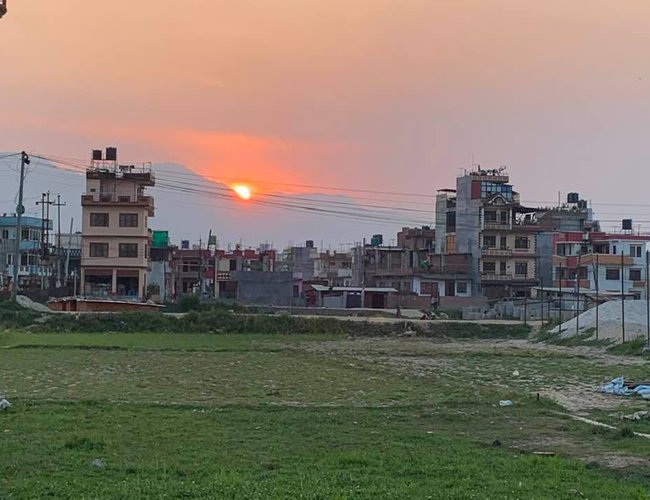
In Nepal, Bikram Sambat/ Vikram Samvat (B.S) is recognized as an official and legal Nepali Calendar. This year it begins from April 14 and Official Holiday in as New Year.. Each year, the new Sambat starts after Chaitra Sankranti (mid-April).
The Rana dynasty of Nepal made the Bikram Sambat the official Hindu calendar in 1901 CE, which began as 1958 BS. The new year in Nepal begins with the first day of the month of Baisakh, which usually falls around 13–15 April in the Gregorian calendar and ends with the last day of the month Chitra. Nepal celebrated over half dozens of different New Year basic on ethnic groups. However, Vikram Sambat is recognized as legal new year. Bisket Jatra, an annual carnival in Bhaktapur, is also celebrated on Baishakh 1.
The Vikram Samvat has two systems. It began in 56 BCE in the southern Hindu calendar system (amaanta) and 57–56 BCE in the northern system (purnimaanta). The Shukla Paksha, when most festivals occur, coincides in both systems. The lunisolar Vikram Samvat calendar is 56.7 years ahead of the solar Gregorian calendar; the year 2080 BS begins mid-April 2023 CE, and ends mid-April 2024 CE.
Sake And Vikram Sambat
In India, the reformulated Saka calendar is officially used (except for computing dates of the traditional festivals). In the Hindi version of the preamble of the constitution of India, the date of its adoption (26 November 1949) is presented in Vikram Samvat as Margsheersh Shukla Saptami Samvat 2006. A call has been made for the Vikram Samvat to replace the Saka calendar as India's official calendar.
The Vikram Samvat uses lunar months and solar sidereal years. Because 12 months do not match a sidereal year, correctional months (adhika māsa) are added or (occasionally) subtracted (kshaya masa). A lunar year consists of 12 months, and each month has two fortnights, with a variable duration ranging from 29 to 32 days. The lunar days are called tithis. Each month has 30 tithis, which vary in length from 20 to 27 hours. The waxing phase, beginning with the day after the new moon (amavasya), is called gaura or shukla paksha (the bright or auspicious fortnight). The waning phase is called krishna or vadhya paksha (the dark fortnight, considered inauspicious.
Vikram Samvat (IAST: Vikrama Samvat; abbreviated VS) or Bikram Sambat B.S. and also known as the Vikrami calendar, is a Hindu calendar historically used in the Indian subcontinent. Vikram Samvat is generally 57 years ahead of Gregorian Calendar, except during January to April, when it is ahead by 56 years. Alongside Nepal Sambat, it is one of the two official calendars used in Nepal. In India, it is used in several states.[1][2] The traditional Vikram Samvat calendar, as used in India, uses lunar months and solar sidereal years. The Nepali Bikram Sambel, introduced in 1901, also uses a solar sidereal year.
History
A number of ancient and medieval inscriptions used the Vikram Samvat. Although it was reportedly named after the legendary king Vikramaditya, the term "Vikrama Samvat" does not appear in the historical record before the 9th century; the same calendar system is found with other names, such as Krita and Malava.[3] In colonial scholarship, the era was believed to be based on the commemoration of King Vikramaditya expelling the Sakas from Ujjain. However, later epigraphical evidence and scholarship suggest that this theory has no historical basis. During the 9th century, epigraphical artwork began using Vikram Samvat (suggesting that the Hindu calendar era in use became popular as Vikram Samvat); Buddhist and Jain epigraphy continued to use an era based on the Buddha or the Mahavira.
Vikramaditya legend
Two illustrated portions of a manuscript
The Jain monk Kalakacharya and the Saka king (Kalakacharya Katha manuscript, Chhatrapati Shivaji Maharaj Vastu Sangrahalaya, Mumbai)
According to popular tradition, King Vikramaditya of Ujjain established the Vikrama Samvat era after defeating the Śakas. Kalakacharya Kathanaka (An account of the monk Kalakacharya), by the Jain sage Mahesarasuri, gives the following account: Gandharvasena, the then-powerful king of Ujjain, abducted a nun called Sarasvati, who was the sister of the monk. The enraged monk sought the help of the Śaka ruler King Sahi in Sistan. Despite heavy odds but aided by miracles, the Śaka king defeated Gandharvasena and made him a captive. Sarasvati was repatriated, although Gandharvasena himself was forgiven. The defeated king retired to the forest, where he was killed by a tiger. His son, Vikramaditya, being brought up in the forest, had to rule from Pratishthana (modern Paithan in Maharashtra). Later on, Vikramaditya invaded Ujjain and drove away from the Śakas. To commemorate this event, he started a new era called the "Vikrama era". The Ujjain calendar started around 58–56 BCE, and the subsequent Shaka-era calendar was started in 78 CE at Pratishthana.
Source: Wikipedia and other calendars
- The Situation Pushes Women Journalists To Speak Louder, Experts Emphasize
- Jun 30, 2025
- SPI NEPAL: Prosperity Through Clean Energy
- Jun 30, 2025
- PM Oli Meets Spanish Prime Minister
- Jun 30, 2025
- FM Dr. Rana Said Nepal recognises constitutional guarantees to citizens' right to food
- Jun 30, 2025
- Weather Forecast: Generally Cloudy With Heavy Rainfall Is Likely In One Or Two Places Of Kathamandu, Biratnagar And Pokhara
- Jun 30, 2025















